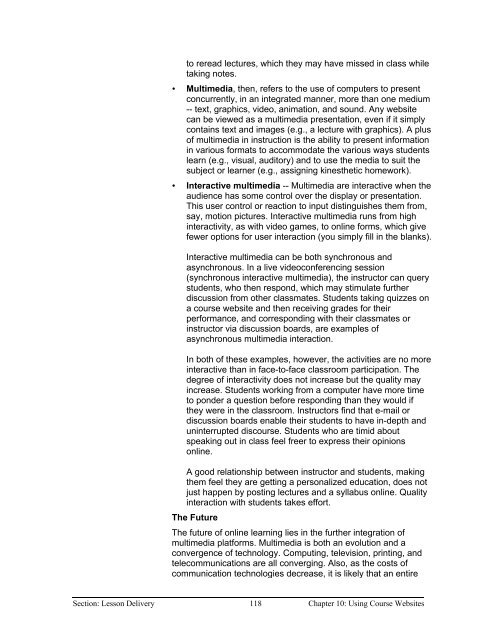Chapter 9 - Instructional Media: Chalkboards to Video - CGISS
Chapter 9 - Instructional Media: Chalkboards to Video - CGISS
Chapter 9 - Instructional Media: Chalkboards to Video - CGISS
Create successful ePaper yourself
Turn your PDF publications into a flip-book with our unique Google optimized e-Paper software.
<strong>to</strong> reread lectures, which they may have missed in class while<br />
taking notes.<br />
• Multimedia, then, refers <strong>to</strong> the use of computers <strong>to</strong> present<br />
concurrently, in an integrated manner, more than one medium<br />
-- text, graphics, video, animation, and sound. Any website<br />
can be viewed as a multimedia presentation, even if it simply<br />
contains text and images (e.g., a lecture with graphics). A plus<br />
of multimedia in instruction is the ability <strong>to</strong> present information<br />
in various formats <strong>to</strong> accommodate the various ways students<br />
learn (e.g., visual, audi<strong>to</strong>ry) and <strong>to</strong> use the media <strong>to</strong> suit the<br />
subject or learner (e.g., assigning kinesthetic homework).<br />
• Interactive multimedia -- Multimedia are interactive when the<br />
audience has some control over the display or presentation.<br />
This user control or reaction <strong>to</strong> input distinguishes them from,<br />
say, motion pictures. Interactive multimedia runs from high<br />
interactivity, as with video games, <strong>to</strong> online forms, which give<br />
fewer options for user interaction (you simply fill in the blanks).<br />
Interactive multimedia can be both synchronous and<br />
asynchronous. In a live videoconferencing session<br />
(synchronous interactive multimedia), the instruc<strong>to</strong>r can query<br />
students, who then respond, which may stimulate further<br />
discussion from other classmates. Students taking quizzes on<br />
a course website and then receiving grades for their<br />
performance, and corresponding with their classmates or<br />
instruc<strong>to</strong>r via discussion boards, are examples of<br />
asynchronous multimedia interaction.<br />
In both of these examples, however, the activities are no more<br />
interactive than in face-<strong>to</strong>-face classroom participation. The<br />
degree of interactivity does not increase but the quality may<br />
increase. Students working from a computer have more time<br />
<strong>to</strong> ponder a question before responding than they would if<br />
they were in the classroom. Instruc<strong>to</strong>rs find that e-mail or<br />
discussion boards enable their students <strong>to</strong> have in-depth and<br />
uninterrupted discourse. Students who are timid about<br />
speaking out in class feel freer <strong>to</strong> express their opinions<br />
online.<br />
A good relationship between instruc<strong>to</strong>r and students, making<br />
them feel they are getting a personalized education, does not<br />
just happen by posting lectures and a syllabus online. Quality<br />
interaction with students takes effort.<br />
The Future<br />
The future of online learning lies in the further integration of<br />
multimedia platforms. Multimedia is both an evolution and a<br />
convergence of technology. Computing, television, printing, and<br />
telecommunications are all converging. Also, as the costs of<br />
communication technologies decrease, it is likely that an entire<br />
infrastructure can be built – and accessed – by most people in the<br />
developed world. A fiber optic infrastructure would allow for larger<br />
Section: Lesson Delivery bandwidths and thus 118 the delivery of <strong>Chapter</strong> more 10: integrated Using Course multimedia Websites<strong>to</strong><br />
homes and offices.
















